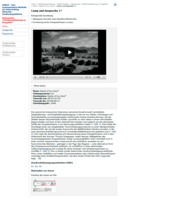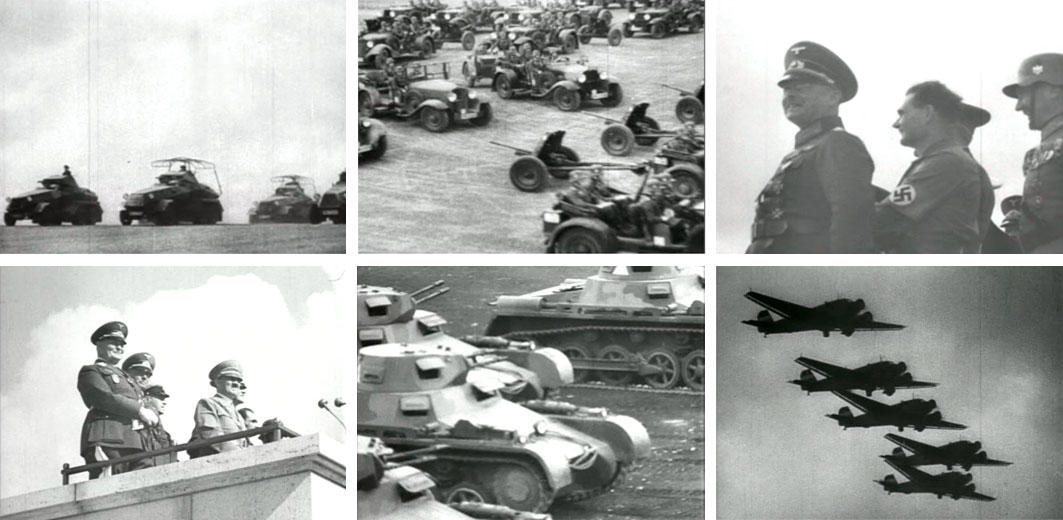Genre, Sense of Community, and History
Research regarding „The Feeling of Spectators and Poetics of Affect” and „The Aesthetics and Politics of Audiovisual Images” interconnects within the investigation of films, genres, and national cinematographies as creating a sense of community: Films negotiate, as goes the basic thesis, the possibilities and sense of a being-together by simultaneously addressing the spectators’ aesthetic perception and historical consciousness.
Genre and Community
In contrast to previous genre theories, cinematic genres are not understood from this perspective as an established, superordinate set of various characteristics in terms of content or motivic conventions. Rather, genres arise from the relationship between specific films. They aim to produce the present and history of a political community through a communally shared perceiving and judging in the first place. Be this community a nation, an ethnically or politically defined group, or a widely shared understanding of culture – genres refer to collectively shared emotions and locate the spectator within a shared relation to a world of sensation.
Genres are thus not regarded as standardized film products, inevitably cementing what already exists, but rather as dynamic communication systems which keep continuously posing fundamental questions of society in new variations.
The monograph Front Lines of Community discusses this topic.
Genres as Dynamic Communication Systems
In Film Genre and Modality. The Incestuous Nature of Genre Exemplified by the War Film (together with Matthias Grotkopp), the question whether genre modalities (reverting back to Christine Gledhill’s idea) can be grasped, finds its origin in a scene of initiation from the war film GUNG HO!. Genres are not regarded as static categories, but rather as dynamic communication systems, as different ways of experiencing the world. Thereby, different genre modalities can be used in varying degrees within one film. The example scene from GUNG HO! can be seen as paradigmatic for the confluence of multiple genre modalities within the genre of the war film.
Further reading:
Film, Genre and Modality. The Incestuous Nature of Genre Exemplified by the War Film. (by Matthias Grotkopp and Hermann Kappelhoff ). In: In Praise of Cinematic Bastardy/ Sébastien Lefait, Philippe Ortoli (eds.). First edition. Newcastle upon Tyne: Cambridge Scholars Publishing, 2012. p. 29-39
Front Lines of Community
„What do the characters in the first sequence of GUNG HO! represent? They are certainly not simply the stereotypical characters of the genre. Neither can their descent be simply processed as narrative information. They cannot be fully appreciated by a taxonomic approach […].
[T]he recruits represent modalities of experience and not ‘dramatis personae.’ They carry with them ways of behaving, ways of using the human body, ways of inhabiting space and time, and ways of getting emotionally involved. The war film is above all a propagandistic effort: ‘The tools of the cinema are employed to manipulate viewers into various emotional, cultural, and intellectual attitudes‘ [Basinger 2003, S.57]. It addresses its spectators by offering them docking sites that constitute a common ground of emotional participation, a world they are familiar with, a world in which they are located.
The war film inserts itself into the existing genre system, not only as a tool for organising studio production and audience reception, but as a system of communication by which a society constitutes its values and its identity.“ (Film Genre and Modality. The Incestuous Nature of Genre Exemplified by the War, p. 30f.)
Mobilization of the Senses
The Hollywood-war-film, which negotiates basic questions of community through specific affect dramaturgies, is a paradigm for such a function of genre systems as societal emotion machines.
At the center of the investigation of the war film genre in the anthology Mobilisierung der Sinne is the question of feelings of community which bind individuals to the idea and values of a society. This mobilization of the spectators’ senses, as produced by Hollywood war films, connects the spectators’ specific self-experience during the reception of the film with an abstract idea of community. The War reflected in Genre Cinema – the connection of the pathos of the Hollywood-war-film with the historical experience of war – describes a cultural fantasy; which primarily creates a sense of community (and less a modulation of the individual’s moral-political attitude). The essay Der Krieg im Spiegel des Genrekinos: John Fords THEY WERE EXPENDABLE (included in the anthology) uses a specific film example in order to explain and illustrate the research methods which were developed in a series of research projects.
Further information about the book: Mobilisierung der Sinne
“The music, the camera angles, dominated by the breadth of the horizon, as well as the harmonic rhythm of the movement of camera and boats already form the very first minutes of the film in expressive modalities quite similar to those found in John Ford’s Westerns. [...] The first scene of the film introduces the spectator to the purely sensually associated imagination of an extraterritorial outpost of the American nation – it does not need much imagination to add horses and trumpet calls, and to transform the water into clouds of dust. Consequently, this imagination is joined by the stolidity of the generals and the static geometry of the soldiers called to roll call: the technologically enhanced and cinematographically choreographed experience of omnipotence comes to an abrupt halt with the long run of the boats into the port, and the crew is lined up for the generals in their white parade uniforms. [...]” (translation of Mobilisierung der Sinne, p. 206f, see also Kappelhoff, Hermann: Front Lines of Community. Hollywood Between War and Democracy. Berlin/Boston 2018, p. 240f.)
Staging the Images of War
The research project „Mobilization of Emotions in War Films“ (2008 – 2011 cluster of excellence “Languages of Emotion”, Freie Universität Berlin, PI: Hermann Kappelhoff), as well as its follow-up project „Staging images of war as a mediated experience of community“ (since 2011, DFG-funded, Freie Universität Berlin, PI: Hermann Kappelhoff) were dedicated to the researching of the Hollywood-war-film-genre regarding its aesthetic strategies of emotionalization – thus, they tried to answer the question, through which audiovisual modes of staging audiences are affected. The research focused on basic pathetic image complexes, which are repeated varyingly in the different films. By analyzing these central narrative constellations, aesthetic strategies, and areas of affect, it was possible to establish a set of eight pathos scenes, which fan out the emotional spectrum in which the films of the genre are located.
The extensive data corpus is available online in the database of the project. It contains a number of systematic analyses of various war films.
The comparative online-publication, Kriegerische Mobilisierung: Die mediale Organisation des Gemeinsinns, as well as the essay Affektmobilisierung und mediale Kriegsinszenierung, which contrast Frank Capra’s WHY WE FIGHT-films with Leni Riefenstahl’s TAG DER FREIHEIT – UNSERE WEHRMACHT, show how differently the relation of the military, society, and the individual can be staged. Both of these propaganda formats utilize very different strategies of emotionalization with which they affect their audience, as well as promoting very different ideas of society.
“Capra and Riefenstahl each propagate an ideal of community, but they could not be more opposed. And this opposition can be grasped in the most diverse staging techniques. Riefenstahl uses the avant-garde art of montage to construct a homogenous perceptual perspective, which allows the spectator to take part in staging the power of the state. She lets the spectator share in the Führer’s gaze, enthroned above at a vantage point from which he can enjoy the war as spectacle and the annihilation of the person as the birth of a new ethnic community. Capra, on the other hand, multiplies the perspectives and standpoints by using montage to juxtapose highly heterogeneous modes of representation. Each of these modes has a different perspective, a different affective stance to the world: the montage of association, the cross-section montage, the mode of melodrama, and that of the gangster film.
This multiplication of perspectives confronts the heroic self-representation of the fascist state with the clash between opposing subjective stances and affective positionings – rage, pity, fear, indignation, horror. It deciphers this staging as a celebration of war that grounds the life forms of the fascist national community by negating any deviation that serves to individualize. Capra uses the representational modes of cinema to lay bare the ideal of community in the enemy’s propaganda films. He challenges the judgment of his contemporaries in relation to this ideal, in order to mobilize the sense of community in them, the feeling of belonging to a completely different community.” (Kappelhoff, Hermann: Front Lines of Community. Hollywood Between War and Democracy. Berlin/Boston 2018, p. 63)
Moral Feelings in the Recent War Film
Sense of Community: Die filmische Komposition eines moralischen Gefühls uses two film-analytical sketches of SAVING PRIVATE RYAN and WINDTALKERS to illustrate how recent Hollywood war films also use their aesthetic design to model affective ties to an overarching political ideal of community.
The former leads the depiction of war back to the primal scene of sentimental entertainment culture in its last scene, in which the family assembles around the death bed and merges to a community of rectified perceiving and feeling.
"In fact, private Ryan’s family, positioned in a half-circle in the background of the image, confronts the film spectator as a community, literally drawing him or her into their circle; indeed, they are connected through the shared gaze at one and the same scene of someone weeping at a graveside – as if the circle of community were closing around the mourning face together with the gaze of the anonymous audience in front of the screen. The montage breaks up the figuration with a line crossing in order to link this community of sentimental remembrance in a circular sequence of shots directly with the symbol of the nation: the flag of the United States of America." (Front Lines of Community, p. 15)
Cultural Fantasy Work in the War Film
The function of the image of the soldier’s suffering is investigated in Shell shocked face: Einige Überlegungen zur rituellen Funktion des US-amerikanischen Kriegsfilms as an economy of cultural fantasy work based on a viewing of war films all throughout the second half of the twentieth century.
The focus is on the spectator’s pleasure in the cinema, which is the base of the ritualized visit to the cinema, as well as on the pathos formulas of the classic war film and their manifestations in current cinema.
"Man könnte sagen, der Film [WINDTALKERS] spiegelt den Mythos von der Geburt der Nation in einer melodramatischen Figuration des Kriegsfilms. Anders als bei Spielberg ist es keine verinnerlichende, sondern eine ironische Spiegelung. Sie zielt auf den Modus der Rede vom Krieg: die Erzählung vom Krieg der Rassen, dem Kampf der Kulturen, dem sich ständig verschiebenden Frontverlauf des Fremden. In der Verschmelzung der rhetorischen Elemente von Western und Actionkino mit denen des Melodramas wird diese Front in den Raum des ästhetischen Erlebens der Zuschauer verlegt: Dieser Raum umgreift sein Hören und Sehen, lässt ihn Teil einer kulturellen Fusion werden, die nicht nur Indianer und Japaner erfasst hat."
(Shell shocked face: Einige Überlegungen zur rituellen Funktion des US-amerikanischen Kriegsfilms. In: Verklärte Körper / Nicola Suthor, Erika Fischer-Lichte (eds.). First edition. München: Wilhelm Fink, 2006. p. 85f.)
"You could say that the film [WINDTALKERS] reflects the myth of the birth of a nation in a melodramatic figuration of the war film. Unlike with Spielberg, it is not an internalizing, but an ironic reflection. It is aimed at the mode of talking about war: the narrative of the war of races, the clash of cultures, the constantly shifting front line of the other. In the fusion of the rhetorical elements of Western and action cinema with those of melodrama, this front is transferred to the space of the viewer's aesthetic experience: this space embraces their hearing and seeing, allowing them to become part of a cultural fusion that has encompassed not only Indians and Japanese."
Post-War-Cinema and the Question of Community
The question of community – whether and wherein a unit of society can be founded and how the shared life is to be understood and managed – shaped the cinematographies of Western Europe after the Second World War. Film as a cultural practice (according to Rancière) expressed various aesthetic strategies and poetological forms, in order to specifically negotiate this question in Neorealism, in the Trümmerfilm, or in the French post-war cinema. However, the task is to question the established film historical ‘truths’ of the successful Neorealism and the failed Trümmerfilm, or the aesthetically enlightened auteur cinema in contrast to the seemingly retrograde genre cinema: what were the scope and the limits of the democratization of perception after 1945?
Further reading:
Die Frage der Gemeinschaft. Das westeuropäische Kino nach 1945. Edited by Hermann Kappelhoff und Anja Streiter
Demokratisierung der Wahrnehmung? Das westeuropäische Nachkriegskino. Edited by Hermann Kappelhoff, Bernhard Groß, Daniel Illger
The Politics of Aesthetics in Western-European Cinema
The project Die Politik des Ästhetischen im westeuropäischen Kino (PI: Hermann Kappelhoff) was located at the Sonderforschungsbereich 626 "Ästhetische Erfahrung im Zeichen der Entgrenzug der Künste" at Freie Universität Berlin. The project’s central questions are: how can the relation of aesthetic experience and politics (through Rancière) be understood based on Western-European post-war-films? How do poetics of affect address the spectator as an individual who partakes in communal living? Do different poetics of affect constitute different genres? And do genres amongst one another form something like an affect-poetic system? And how does genre cinema make judgement processes (in the sense of Hannah Arendt) tangible?
In addition to this, during its second funding period (2011 – 2014), the project also focussed on the post-war auteur cinema, before it turned to the genre cinema as a second dominant of post-war cinema.










